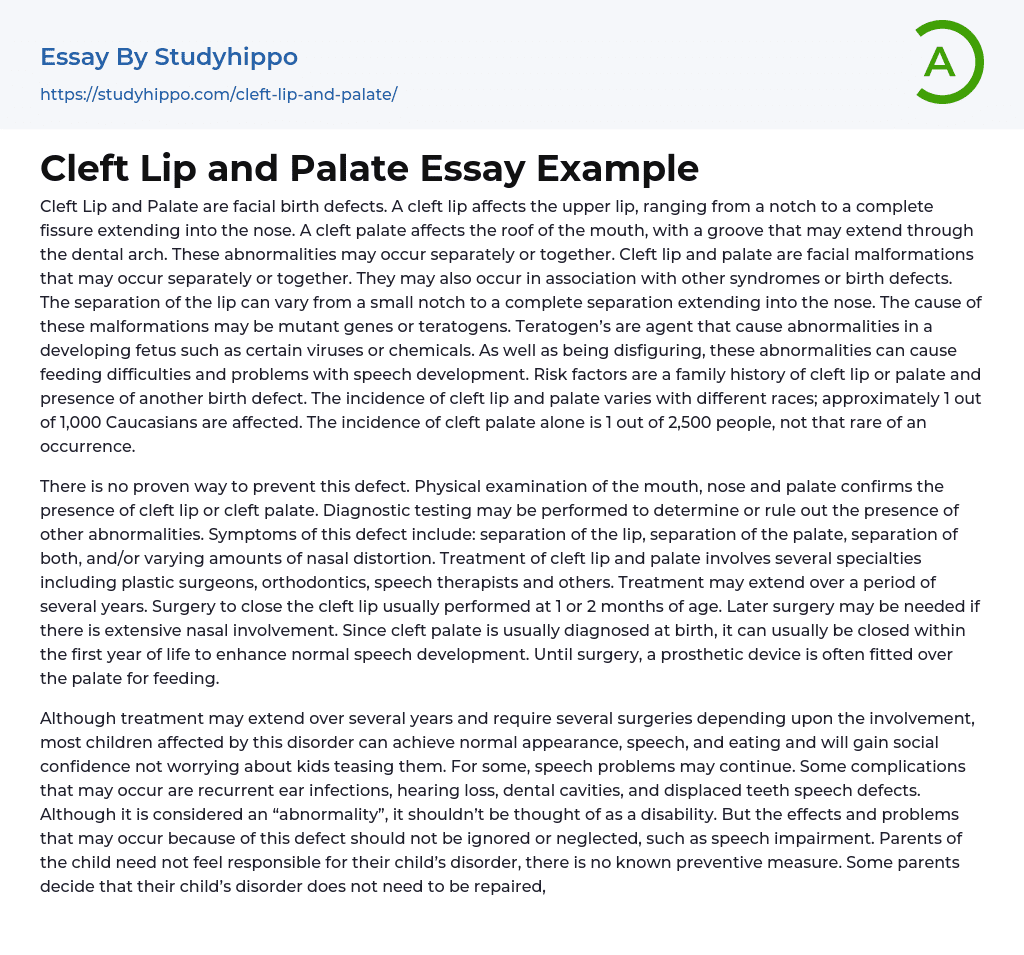Cleft Lip and Palate are facial birth defects. A cleft lip affects the upper lip, ranging from a notch to a complete fissure extending into the nose. A cleft palate affects the roof of the mouth, with a groove that may extend through the dental arch. These abnormalities may occur separately or together. Cleft lip and palate are facial malformations that may occur separately or together. They may also occur in association with other syndromes or birth defects. The separation of the lip can vary from a small notch to a complete separation extending into the nose. The cause of these malformations may be mutant genes or teratogens. Teratogen’s are agent that cause abnormalities in a developing fetus such as certain viruses or chemicals. As well as being disfiguring, these abnormalities can cause feeding difficulties and problems with spe
...ech development. Risk factors are a family history of cleft lip or palate and presence of another birth defect. The incidence of cleft lip and palate varies with different races; approximately 1 out of 1,000 Caucasians are affected. The incidence of cleft palate alone is 1 out of 2,500 people, not that rare of an occurrence.
There is no proven way to prevent this defect. Physical examination of the mouth, nose and palate confirms the presence of cleft lip or cleft palate. Diagnostic testing may be performed to determine or rule out the presence of other abnormalities. Symptoms of this defect include: separation of the lip, separation of the palate, separation of both, and/or varying amounts of nasal distortion. Treatment of cleft lip and palate involves several specialties including plastic surgeons, orthodontics, speech therapist
and others. Treatment may extend over a period of several years. Surgery to close the cleft lip usually performed at 1 or 2 months of age. Later surgery may be needed if there is extensive nasal involvement. Since cleft palate is usually diagnosed at birth, it can usually be closed within the first year of life to enhance normal speech development. Until surgery, a prosthetic device is often fitted over the palate for feeding.
Although treatment may extend over several years and require several surgeries depending upon the involvement, most children affected by this disorder can achieve normal appearance, speech, and eating and will gain social confidence not worrying about kids teasing them. For some, speech problems may continue. Some complications that may occur are recurrent ear infections, hearing loss, dental cavities, and displaced teeth speech defects. Although it is considered an “abnormality”, it shouldn’t be thought of as a disability. But the effects and problems that may occur because of this defect should not be ignored or neglected, such as speech impairment. Parents of the child need not feel responsible for their child’s disorder, there is no known preventive measure. Some parents decide that their child’s disorder does not need to be repaired, but it would only benefit the child when they grow older, both in a physical aspect and in the emotional aspect because the world is cruel and not very accepting of those that are “different” from the majority.
Bibliography
1.Better Homes and Gardens Family Medical Guide 2.Funk and Wangalls Encyclopedia 3.Microsoft Encarta98 Encyclopedia 4.www.healthhelp.com 5.Cleft Lip and Palate Parent’s Guide, By J.R. Thompkins
- Emergence essays
- Anxiety Disorder essays
- Post-traumatic Stress Disorder essays
- Cloning essays
- Medical Ethics essays
- Patient essays
- Therapy essays
- drugs essays
- Cannabis essays
- Aspirin essays
- Cardiology essays
- Hemoglobin essays
- Pharmacology essays
- Surgery essays
- alternative medicine essays
- Plastic Surgery essays
- Organ Donation essays
- Vaccines essays
- Medical essays
- Dentist essays
- Psychological Trauma essays
- Physical therapy essays
- Cold essays
- Cocaine essays
- Why Marijuana Should Be Legalized essays
- Drug Abuse essays
- Teenage Drug Abuse essays
- Heart Disease essays
- Artery essays
- Addiction essays
- Anatomy and Physiology essays
- Biodegradation essays
- Cancer essays
- Dental Care essays
- Disability essays
- Disease essays
- Disorders essays
- Health Care essays
- Infectious Disease essays
- Inquiry essays
- Intelligence Quotient essays
- Lung Cancer essays
- Medicine essays
- Neurology essays
- Nutrition essays
- Olfaction essays
- Physical Exercise essays
- Public Health essays
- Sex essays
- Women's Health essays




